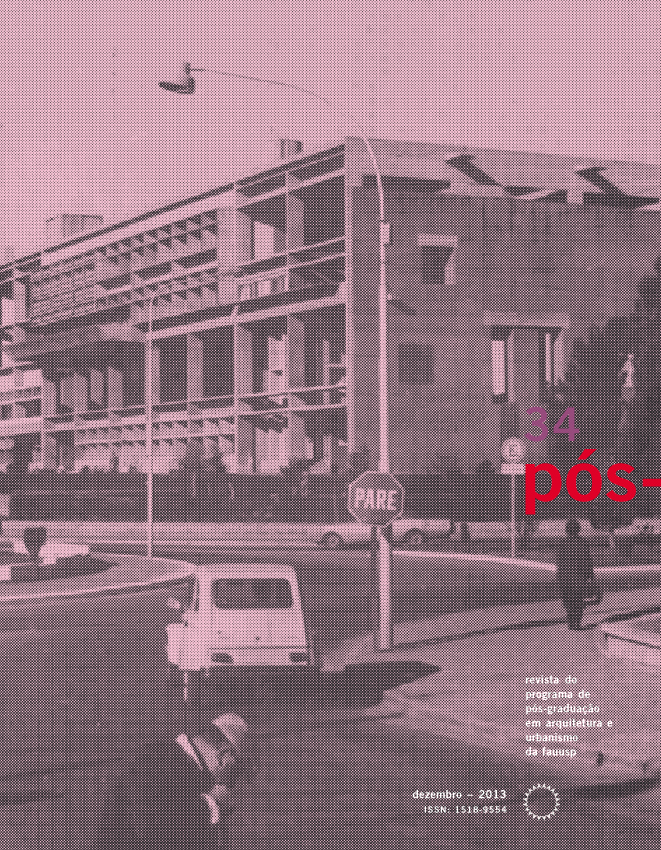O "sujeito sociológico" pelas ruas de Brasília
DOI:
https://doi.org/10.11606/issn.2317-2762.v20i34p126-139Palavras-chave:
Sujeito sociológico. Indivíduo moderno. Brasília. Carta de Atenas. Urbanismo modernista. Cidade modernista. Sociologia urbana (Brasília).Resumo
Este artigo pretende situar o “sujeito sociológico”, conceituado por Stuart Hall (2006), na arquitetura e urbanismo modernistas, utilizando como ícone a cidade de Brasília. Este “sujeito sociológico”, fruto da modernidade em transformação, com suas características de isolamento e individualismo acrescidas de um processo de fragmentação e descentramento das identidades, será conduzido pelas ruas da cidade símbolo de nosso modernismo, concebida, em grande parte, com base nos princípios da Carta de Atenas, que objetivava resolver os problemas decorrentes do rápido crescimento das cidades. Buscamos compreender de que forma os princípios modernistas da Carta de Atenas, manifesto mais significativo do Congresso Internacional de Arquitetura Moderna (Ciam), estão presentes em Brasília e como se dá a relação entre o coletivo e o individual, bem como de que maneira o “sujeito sociológico” pode transitar em seus espaços. Para isto, analisamos os princípios da Carta de Atenas aplicados ao projeto urbanístico de Brasília, e como resultou, na prática, a relação do indivíduo, nosso “sujeito sociológico”, com esta “cidade ideal”, pela observação das relações entre o coletivo e o individual, o público e o privado, o centro e a periferia. Consideramos, também, o período político e econômico do País, na década de 1950 e início da década de 1960, com a política desenvolvimentista do governo de Juscelino Kubitschek, em diálogo com os preceitos da cidade modernista ideal. Sendo assim, nossa análise gira em torno do “sujeito sociológico”, individualista, pertencente à sociedade moderna em transformação, em diálogo com as estruturas do estado-nação, da industrialização, da democracia e do capitalismo modernos, inserido em uma cidade modernista, com aspirações de coletividade e ordem social e espacial, em um País voltado para o futuro, o progresso e o desenvolvimento.Downloads
Referências
BRADBURY, Malcolm; MCFARLANE, James. O nome e a natureza do modernismo. In: BRADBURY, Malcolm. (Org.). Modernismo: guia geral 1890-1930. São Paulo: Companhia das Letras, 1989. 586 p.
CERTEAU, Michel de. A invenção do cotidiano: artes de fazer. Petrópolis: Vozes, 1994. 351 p.
COELHO, Christiane Machado. Utopias urbanas: o caso de Brasília e Vila Planalto. Cronos (Natal), v.9, n.1, jan./jun. 2008. Disponível em: http://www.cchla.ufrn.br/cronos/pdf/9.1/d5.pdf. Acesso em: 15 dez. 2011.
DAMATTA, Roberto. A casa e a rua: espaço, cidadania, mulher e morte no Brasil. Rio de Janeiro: Rocco, 2000. 164 p.
FRAMPTON, Kenneth. História crítica da arquitetura moderna. Tradução de Jefferson Luiz Camargo. São Paulo: Martins Fontes, 1997. 529 p.
GALBIERI, Thalita Ariane. Os planos para a cidade no tempo. Resenhas Online, v. 7, n. 79, jul. 2008. Disponível em: http://www.vitruvius.com.br/revistas/read/resenhasonline/07.079/3069. Acesso em: 15 dez. 2011.
CANCLINI, Néstor G. Culturas híbridas: estratégias para entrar e sair da Modernidade. São Paulo: EDUSP, 2003. 416 p.
HALL, Stuart. A identidade cultural na pós-modernidade. Tradução de Tomaz Tadeu da Silva, Guacira Lopes Louro. Rio de Janeiro: DP&A, 2006. 104 p.
HARVEY, David. Condição pós-moderna: uma pesquisa sobre as origens da mudança cultural. São Paulo: Edições Loyola, 2004. 349 p.
HOLANDA, Frederico de. O espaço de exceção. Brasília: Editora Universidade de Brasília, 2002. 466 p.
HOLSTON, James. A cidade modernista: uma crítica de Brasília e sua utopia. São Paulo: Companhia das Letras, 1993. 362 p.
IRAZÁBAL, Clara. Da Carta de Atenas à Carta do Novo Urbanismo: qual seu significado para a América Latina? Arquitextos, v. 2, n. 19, dez 2001. Disponível em: http://www.vitruvius.com.br/revistas/read/arquitextos/02.019/821. Acesso em: 15 dez. 2011.
KANASHIRO, Milena. Da antiga à nova Carta de Atenas: em busca de um paradigma espacial de sustentabilidade. Desenvolvimento e Meio Ambiente, n. 9, p. 33-37, ago. 2005.
LE GOFF, Jacques. História e memória. Campinas: Editora da UNICAMP, 1990. 528 p.
OLIVEIRA, Lucia Lippi. A redescoberta do Brasil nos anos 1950: entre o projeto político e o rigor acadêmico. In: MADEIRA, Angélica; VELOSO, Mariza. (Org.). Descobertas do Brasil. Brasília: Editora da UnB, 2001. 331 p.
OLIVEIRA, Lucia Lippi. Cidade e cotidiano como arena cultural: uma reflexão sobre o Rio de Janeiro. Alpharrabios, v.1, n. 2, 2008. Disponível em: http://eduep.uepb.edu.br/alpharrabios/v2n1/pdf/CIDADE_E_COTIDIANO_COMO_ARENA_CULTURAL.pdf. Acesso em: 15 abr. 2012.
SILVA, Kalina Vanderlei; SILVA, Maciel Henrique. Dicionário de conceitos históricos. São Paulo: Contexto, 2010. 439 p.
Downloads
Publicado
Edição
Seção
Licença
O detentor dos direitos autorais é o autor do artigo. A revista exige apenas o ineditismo na publicação do artigo. O autor tem do direito de divulgar seu artigo conforme sua conveniência devendo citar a revista.
DIADORIM - Diretório de Políticas Editoriais












